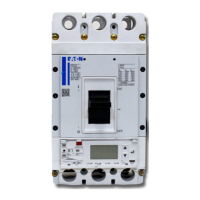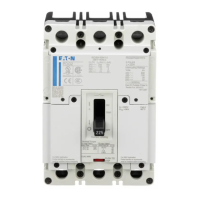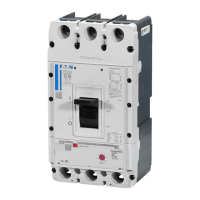
Do you have a question about the Eaton Power Xpert PXR 20D and is the answer not in the manual?
| Brand | Eaton |
|---|---|
| Model | Power Xpert PXR 20D |
| Category | Circuit breakers |
| Language | English |
Overview of protection functionality available in the PXR family trip units.
Describes electrical system information metered by the trip unit.
Details the accuracy of metered data across different ranges.
Explains the algorithm for determining trip unit health status.
Details options for built-in and modular communication capabilities.
Explains how trip units allow full control of the breaker via I/O or communications.
Covers status indicators, USB port, pickup/trip indicators, and reset button.
Details the battery's role in maintaining cause-of-trip indicators.
Explains the function of high load indicators on specific models.
Describes the switch for Arc Flash Reduction Maintenance System (ARMS).
Describes the physical push-to-trip button for manual breaker tripping.
Details the cover for preventing unauthorized setting changes.
Explains the four-digit password for security and testing.
Information on identifying trip units via catalog number and rated current.
Use of QR codes for product information lookup.
Describes the UI for models with a display and keypad.
Details the user interface using rotary switches for settings.
Describes the simpler rotary switch interface on PXR 10 models.
Details settings for long delay pickup (Ir) and time delay (tr).
Options for selecting long delay current curves (I²t, I⁴t).
Explains the Long Time Memory (LTM) function for overload protection.
Details settings for short delay pickup (Isd) and time delay (tsd).
Describes the instantaneous pickup (li) setting for immediate tripping.
Explains ground fault detection and action modes (OFF, Alarm, Trip).
Settings for ground fault time delay and slopes (flat, I²t).
Explains ground fault memory for intermittent faults.
Describes ground fault alarm indication and relay configuration.
Explains modes for sensing ground faults (residual, source/zero sequence).
Covers NEC and UL requirements for ground fault testing.
Covers Over/Under Voltage, Unbalance, Phase Loss, and Phase Rotation functions.
Explains how to actuate and indicate Maintenance Mode.
Describes the override trip function reacting to peak current.
Explains the ZSI function for selective tripping and coordination.
Details over-temperature protection for electronic components.
Overview of communication support features like USB and CAMs.
Details the integrated Modbus RTU communication protocol.
Describes the USB port for configuration, control, and testing.
Explains the use of CAMs for connecting to field bus networks.
Provides wire colors, short names, and notes for external connections.
Explains the importance and requirements of auxiliary power.
Details the configuration screen for viewing and editing set points.
Describes secondary injection testing and its benefits.
Explains simulated functional testing for verification.
Describes testing continuity of Rogowski coils.
Explains testing electrical and mechanical breaker hardware.
Details primary injection testing and its effect on health monitor.
Covers capturing 'As Found' and 'As Left' parameters and reporting.
Explains parameters monitored by the health algorithm.
Points to where health monitor counters and data can be found.
Steps to reset health monitors using PXPM software.
Steps for resetting health monitors via the device display.
Refers to section for resetting health registers via communications.
Instructions for replacing the trip unit's coin-cell battery.
Information on replacing the Electronic Trip Unit (ETU).
Schema for identifying trip units by catalog number.
Detailed settings for PDG2 PXR 10 LI trip units.
Detailed settings for PDG2 PXR10 LSI trip units.
Motor protection settings for PDG2 PXR10 MLSI units.
Detailed settings for PDC2 PXR10 LI trip units.
Detailed settings for PDC2 PXR10 LSI trip units.
Motor protection settings for PDC2 PXR10 MLSI units.
Detailed settings for PDG2 PXR20 trip units.
Detailed settings for PDC2 PXR20 trip units.
Detailed settings for PDG2 PXR25/20D units.
Motor protection settings for PDG2 PXR25/20D units.
Detailed settings for PDC2 PXR25/20D units.
Detailed settings for PDG3 PXR10 LI trip units.
Detailed settings for PDG3 PXR10 LSI trip units.
Motor protection settings for PDG3 PXR10 MLSI units.
Detailed settings for PDC3 PXR10 LI trip units.
Detailed settings for PDC3 PXR10 LSI trip units.
Motor protection settings for PDC3 PXR17 MLSI units.
Detailed settings for PDC3 PXR20 trip units.
Detailed settings for PDC3 PXR20 trip units.
Detailed settings for PDC3 PXR25/20D units.
Motor protection settings for PDC3 PXR25/20D units.
Detailed settings for PDC3 PXR25/20D units.
Detailed settings for PDG4 PXR10 LI trip units.
Detailed settings for PDG4 PXR10 LSI trip units.
Detailed settings for PDC4 PXR10 LI trip units.
Detailed settings for PDC4 PXR10 LSI trip units.
Detailed settings for PDG4 PXR20 trip units.
Detailed settings for PDG4 PXR20 trip units.
Detailed settings for PDG4 PXR25/20D units.
Detailed settings for PDG4 PXR25/20D units.
Detailed settings for PDG5 PXR20 trip units.
Detailed settings for PDG5 PXR25/20D units.
Detailed settings for PDG6 PXR20 trip units.
Detailed settings for PDG6 PXR25/20D units.
How to view and set Modbus parameters using display or PXPM.
Details the recognized Modbus RTU protocol and transaction limits.
Configuration options for Modbus registers and data access.
Configuration for floating-point data word order (high/low word first).
Configuration for fixed-point data word order (high/low word first).
Defines input status bits and their validation codes.
Explains how events are triggered and provide summary/trip info.
Details registers for historical trip event data.
Details registers for historical alarm event data.
How to remap data object registers using blocks.
Registers reserved for trip unit remote control actions.
Using Modbus function code 08 for internal diagnostics.
Lists sub-function codes and actions for Modbus diagnostics.
Defines primary and secondary status codes for diagnostics.











